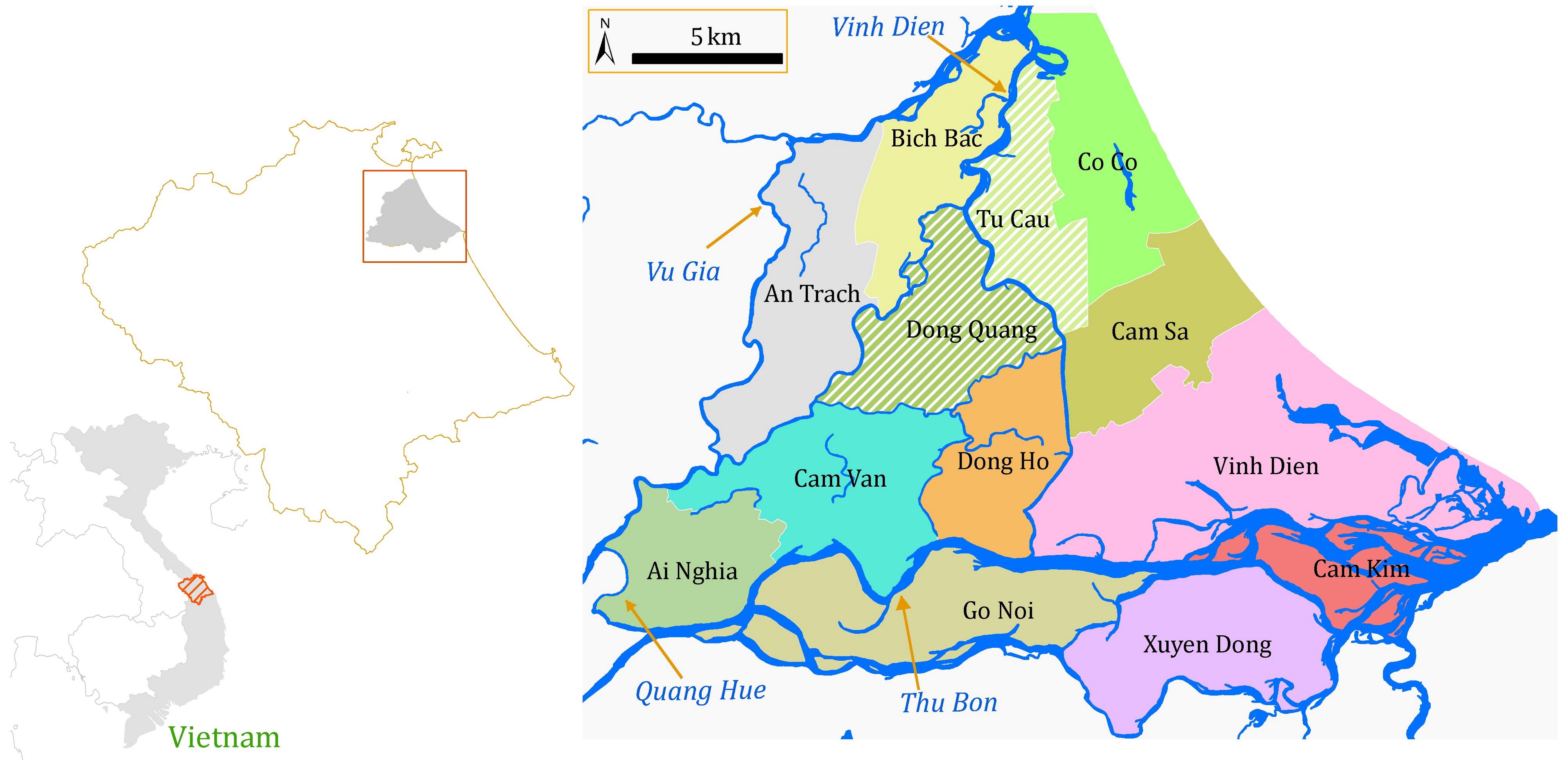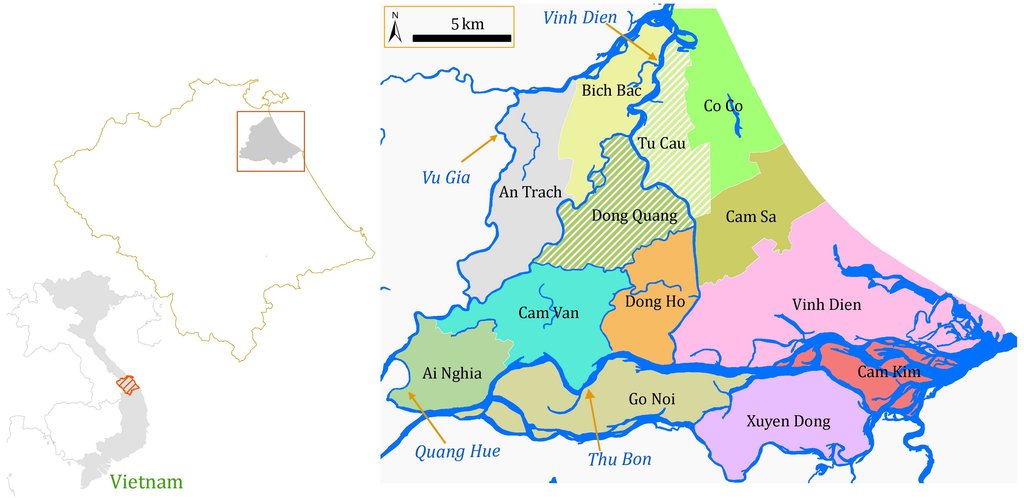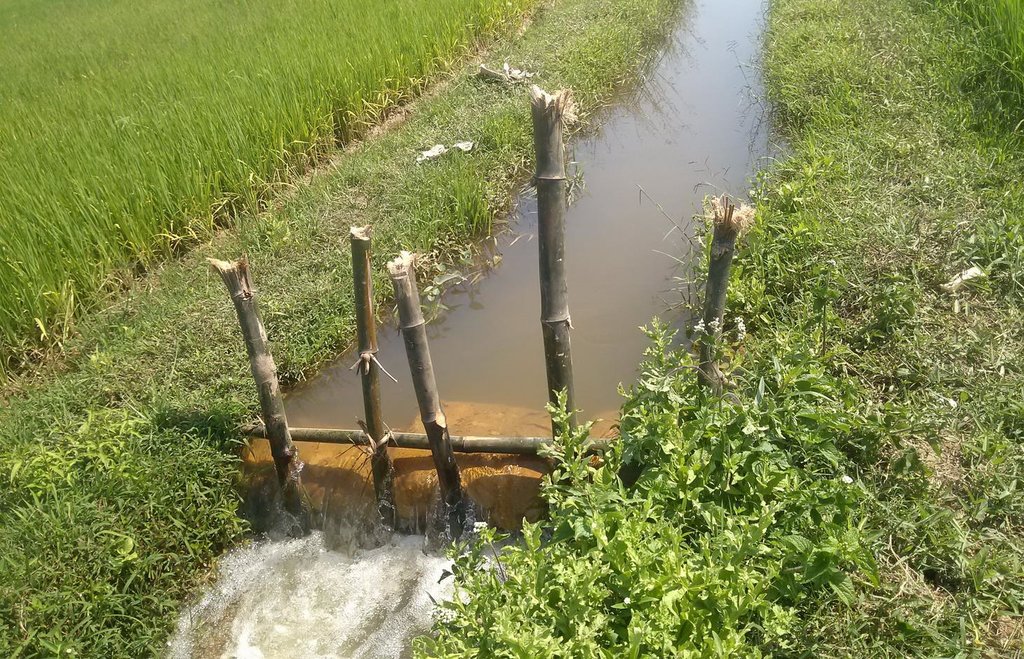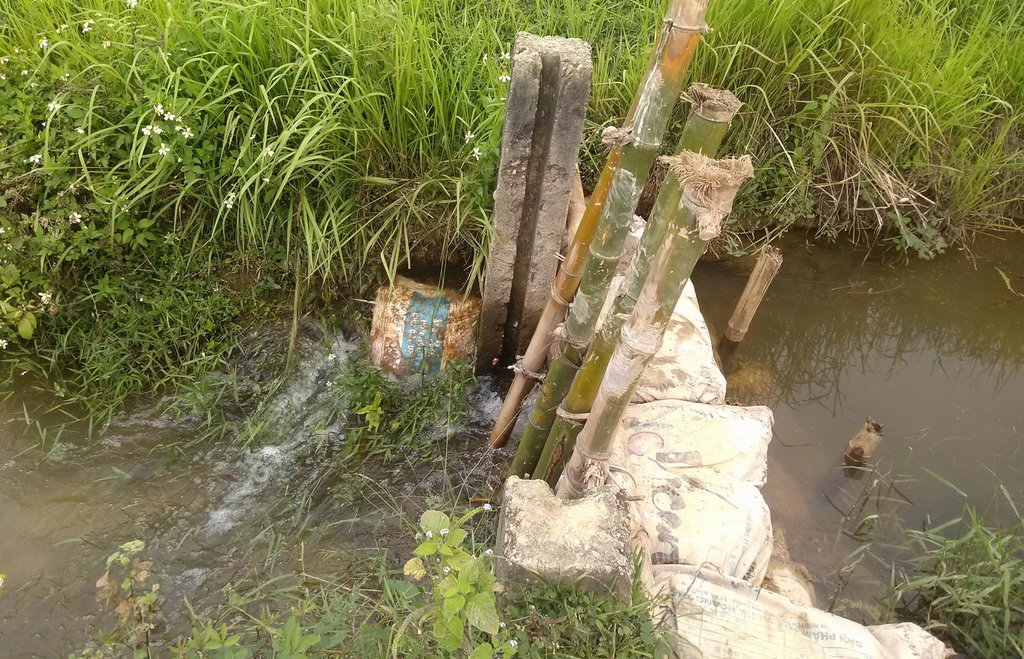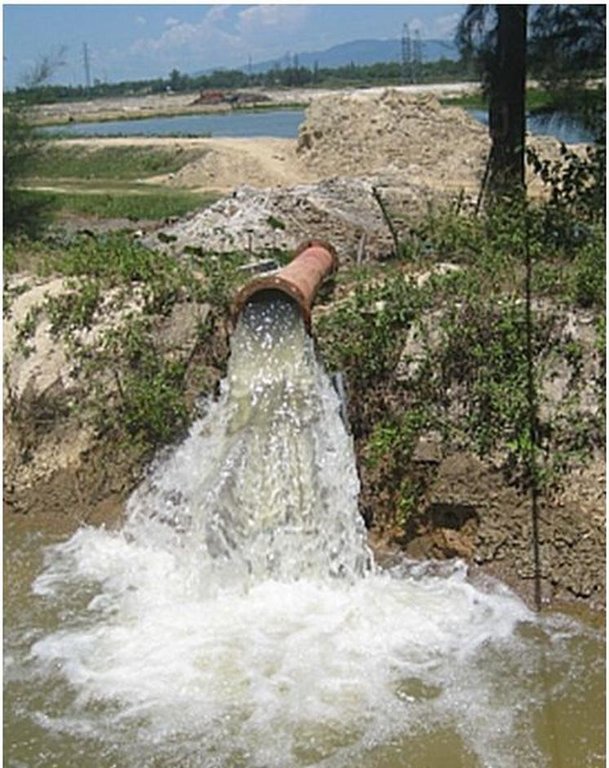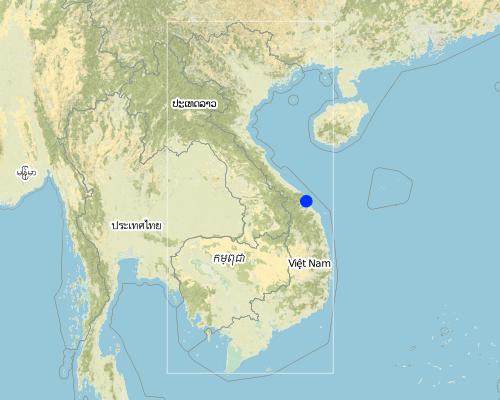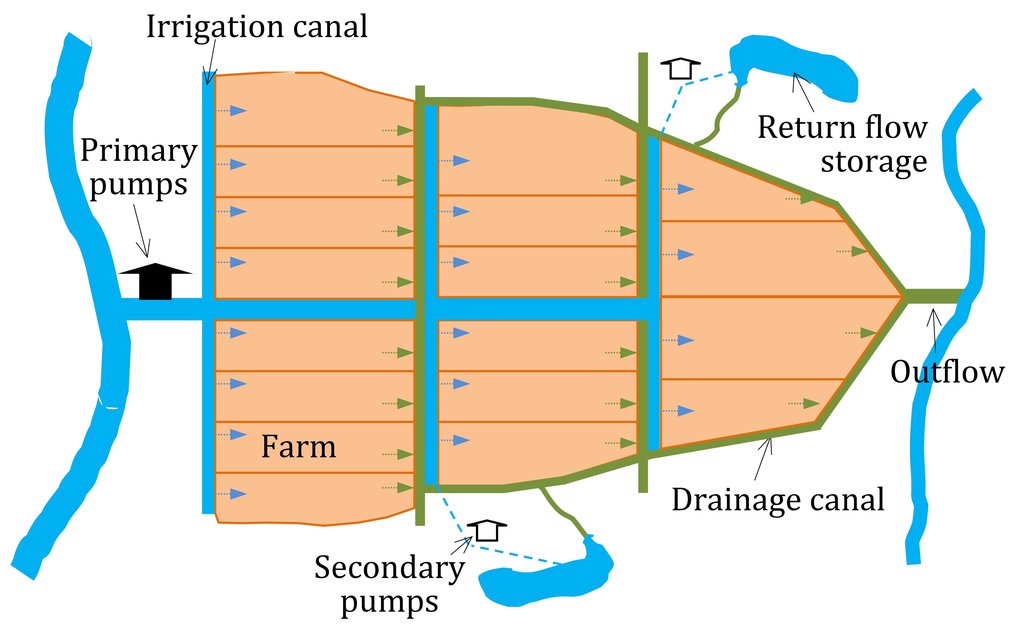Water saving through reuse of return flow in paddy fields [ប្រទេសវៀតណាម]
- ការបង្កើត៖
- បច្ចុប្បន្នភាព
- អ្នកចងក្រង៖ Justyna Sycz
- អ្នកកែសម្រួល៖ –
- អ្នកត្រួតពិនិត្យច្រើនទៀត៖ David Streiff, Deborah Niggli
technologies_1277 - ប្រទេសវៀតណាម
- សង្ខេបជា PDF
- សេចក្តីសង្ខេបពេញលេញជាទម្រង់ PDF សម្រាប់បោះពុម្ព
- សេចក្តីសង្ខេបពេញលេញទម្រង់អ៊ីនធឺនេត
- សេចក្តីសង្ខេបពេញលេញ (មិនមានទម្រង់ជាក់លាក់)
- Water saving through reuse of return flow in paddy fields: 5 ខែ មករា ឆ្នាំ 2017 (inactive)
- Water saving through reuse of return flow in paddy fields: 29 ខែ មេសា ឆ្នាំ 2017 (inactive)
- Water saving through reuse of return flow in paddy fields: 3 ខែ ឧសភា ឆ្នាំ 2017 (inactive)
- Water saving through reuse of return flow in paddy fields: 11 ខែ សីហា ឆ្នាំ 2019 (public)
ពិនិត្យមើលគ្រប់ផ្នែក
ពង្រីកមើលទាំងអស់ បង្រួមទាំងអស់1. ព័ត៌មានទូទៅ
1.2 ព័ត៌មានលម្អិតពីបុគ្គលសំខាន់ៗ និងស្ថាប័នដែលចូលរួមក្នុងការវាយតម្លៃ និងចងក្រងឯកសារនៃបច្ចេកទេស
ឈ្មោះគម្រោងដែលបានចងក្រងឯកសារ/ វាយតម្លៃលើបច្ចេកទេស (បើទាក់ទង)
Book project: Making sense of research for sustainable land management (GLUES)ឈ្មោះគម្រោងដែលបានចងក្រងឯកសារ/ វាយតម្លៃលើបច្ចេកទេស (បើទាក់ទង)
Land Use and Climate Change Interactions in Central Vietnam (LUCCi / GLUES)ឈ្មោះអង្គភាពមួយ (ច្រើន) ដែលបានចងក្រងឯកសារ/ វាយតម្លៃបច្ចេកទេស (បើទាក់ទង)
Technische Hochschule Köln (TH Köln) - ប្រទេសអាល្លឺម៉ង់1.3 លក្ខខណ្ឌទាក់ទងទៅនឹងការប្រើប្រាស់ទិន្នន័យដែលបានចងក្រងតាមរយៈ វ៉ូខេត
តើពេលណាដែលទិន្នន័យបានចងក្រង (នៅទីវាល)?
03/08/2015
អ្នកចងក្រង និង(បុគ្គលសំខាន់ៗ)យល់ព្រមទទួលយកនូវលក្ខខណ្ឌនានាទាក់ទងទៅនឹងការប្រើប្រាស់ទិន្នន័យដែលបានចងក្រងតាមរយៈវ៉ូខេត:
បាទ/ចា៎
1.4 សេចក្តីប្រកាសស្តីពីចីរភាពនៃការពណ៌នាពីបច្ចេកទេស
តើបច្ចេកទេសដែលបានពណ៌នានេះមានបញ្ហាដែលផ្តោតលើការធ្លាក់ចុះគុណភាពដី, បើដូច្នេះវាមិនអាចត្រូវបានប្រកាសថាជាបច្ចេកទេសនៃការគ្រប់គ្រងប្រកបដោយចីរភាពទេ?
ទេ
1.5 ការយោងទៅលើកម្រងបញ្ជីសំណួរនៃវិធីសាស្ត្រផ្សព្វផ្សាយ SLM
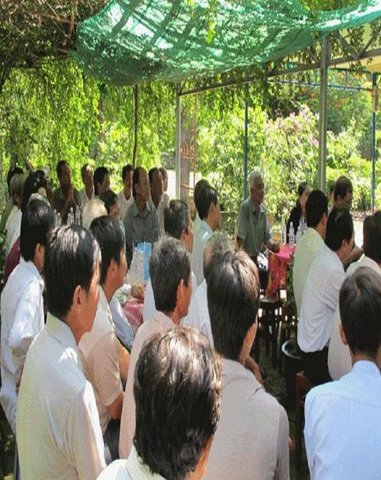
Vu Gia Thu Bon River Basin Information Centre [ប្រទេសវៀតណាម]
The VGTB River Basin Information Centre (RBIC) offers decision support tools for stakeholders and aims at providing comprehensive information and consulting services to the water and land users according to their demands.
- អ្នកចងក្រង៖ Justyna Sycz
2. ការពណ៌នាពីបច្ចេកទេស SLM
2.1 ការពណ៌នាដោយសង្ខេបពីបច្ចេកទេស
និយមន័យបច្ចេកទេស:
Return flow from paddy fields is strategically collected before being lost to rivers and is reused as an effective source of agricultural water.
2.2 ការពណ៌នាលម្អិតពីបច្ចេកទេស
ការពណ៌នា:
Return flow from paddy fields is defined as applied water that is not lost by evapotranspiration but returns to an aquifer or surface water body (Womach, 2005). The two types of return flow are surface and sub-surface. Surface return flow accounts for the major proportion. If surface return flow is strategically collected before entering rivers, it can be used as an ‘extra’ effective source of agricultural water supply (Phil King, 2008; Simons et al., 2015). Because paddies effectively purify water by absorbing nitrogen and phosphorus, this produces return flow of an acceptable quality for irrigation purposes. Return flow can be collected by drainage canals and stored in ponds and reservoirs, and then returned to pumps for reapplication. This technology offers one solution towards overcoming a deficit of irrigation water.
The goal of this technology is to store and reuse surface return flow from paddy farms to enhance irrigation efficiency. The purpose of constructing temporary barriers in drainage canals is to minimise water wastage and optimise the possibility of collecting and recycling surface return flow. Return flow from irrigation system is stored in surrounding ponds and reservoirs Return flow can only be used when it is captured in a storage structure or drain which has a hydraulic link to the irrigation source: thus an integrated framework for the reuse system consisting of both hydraulic, and management, links should be established. Within the scope of this study, the Water Management Unit (WMU) is understood as an integrated irrigation and drainage system consisting of four components: (i) the hydrological catchment which covers both non-irrigated and irrigated area; (ii) the source scheme generating return flow; (iii) the reuse scheme that is hydraulically connected with the source scheme; and (iv) a drainage system functioning as a harvesting as well as a supply structure.
Before implementing such a system it is recommended to analyse the correlation between irrigation efficiency and reuse of return flow, as well as developing a framework for managing and recycling return flow. Investigation aims at identifying the potential of return flow for irrigation; determining its quantity and quality; and developing an efficient and sustainable reuse framework. Water balance calculations, field measurements, water quality sampling and interviewing are all used for this purpose.
In the study area, long dry seasons cause severe water shortages and problems with saline intrusion. The study area is mainly covered by paddy, vegetables and other annual crops such as maize, sweet potatoes, peanuts and sugarcane. Paddy rice, which consumes a high proportion of the freshwater, is the dominant crop. Agricultural land in the downstream area is irrigated through gravity or pump irrigation systems. Here results indicate that the irrigation efficiency can be improved significantly: the irrigation efficiency of Tu Cau and Thanh Quyt irrigation schemes is projected to increase respectively by 1.8 and 1.4 times.
Reuse of return flow can be applied in all WMUs where the drainage canals are connected with storage tanks. Scientific and technical support tools are offered by the Vu Gia Thu Bon River Basin Information Centre. The centre was established in Danang providing a comprehensive information service to farmers and other water users – it includes capacity building and consulting services also.
2.3 រូបភាពនៃបច្ចេកទេស
2.5 ប្រទេស/តំបន់/ទីតាំងកន្លែង ដែលបច្ចេកទេសត្រូវបានអនុវត្ត និងបានគ្រប់ដណ្តប់ដោយការវាយតម្លៃនេះ
ប្រទេស:
ប្រទេសវៀតណាម
តំបន់/រដ្ឋ/ខេត្ត:
Quang Nam
បញ្ជាក់បន្ថែមពីលក្ខណៈនៃទីតាំង:
Dien Ban
Map
×2.6 កាលបរិច្ឆេទនៃការអនុវត្ត
ប្រសិនបើមិនច្បាស់ឆ្នាំ សូមបញ្ជាក់កាលបរិច្ឆេទដែលប្រហាក់ប្រហែល:
- តិចជាង 10ឆ្នាំមុន (ថ្មី)
2.7 ការណែនាំពីបច្ចេកទេស
សូមបញ្ជាក់តើបច្ចេកទេសត្រូវបានណែនាំឱ្យអនុវត្តដោយរបៀបណា:
- តាមរយៈការបង្កើតថ្មីរបស់អ្នកប្រើប្រាស់ដី
- ពេលកំពុងពិសោធន៍
3. ចំណាត់ថ្នាក់នៃបច្ចេកទេស SLM
3.1 គោលបំណងចម្បង (១ ឬច្រើន) នៃបច្ចេកទេសនេះ
- ធ្វើឱ្យប្រសើរឡើងនូវផលិតកម្ម
- អភិរក្សប្រព័ន្ធអេកូឡូស៊ី
3.2 ប្រភេទដីប្រើប្រាស់មួយប្រភេទ (ច្រើនប្រភេទ) ដែលបានអនុវត្តបច្ចេកទេស

ដីដាំដំណាំ
- ដំណាំប្រចាំឆ្នាំ
មតិយោបល់:
Major land use problems (compiler’s opinion): The lowland part of Vu Gia Thu Bon is an intensive agricultural area. Rice cultivation, which consumes a high proportion of fresh water, accounts for 70% of total agricultural land (Ribbe et al., 2011). Since 2005, due to the impacts of droughts and saltwater intrusion, water for irrigation during the dry seasons has become an increasing problem in the lowland area of this basin. Simultaneously, the irrigation efficiency of this region is relative low. Various measures are applied to address water scarcity for irrigation. Reusing return flow is regarded as a potentially new measure to reduce the severity of the irrigation deficit in dry periods.
Major land use problems (land users’ perception): Based on the information provided by the Department of Natural Resources and Environment (DONRE) for Quang Nam Province, this basin now faces the problem of temporarily insufficient irrigation water. This situation is caused by droughts, insufficient reservoir capacity, salinity intrusion and ineffective irrigation management.
3.3 ព័ត៌មានបន្ថែមអំពីអ្នកប្រើប្រាស់ដី
ការផ្គត់ផ្គង់ទឹកនៅកន្លែងអនុវត្តបច្ចេកទេស:
- ប្រព័ន្ធស្រោចស្រពទាំងស្រុង
ចំនួនសារដែលដាំដំណាំក្នុងមួយឆ្នាំ:
- 2
សូមបញ្ជាក់:
Longest growing period in days: 130, Longest growing period from month to month: 20th December to 28th April; Second longest growing period in days: 110, Second longest growing period from month to month: 20th May to 06th September
3.4 ក្រុម SLM ដែលបច្ចេកទេសស្ថិតនៅក្នុង
- ការស្តុកទុកទឹក
- ការគ្រប់គ្រងទឹកលើដី (ទឹកធ្លាក់ ទន្លេ បឹង សមុទ្រ)
3.5 ការសាយភាយនៃបច្ចេកទេស
មតិយោបល់:
Total area covered by the SLM Technology is 0.916 m2.
The research area is located in the downstream of the Vu Gia Thu Bon Basin (VGTB), Central Coast of Vietnam. Based on the hydraulic connectivity, the lowland of the VGTB is divided into 13 Water Management Units (WMU) (Viet, 2014). Of which, the Dong Quang and Tu Cau WMUs are selected to conduct the field survey and water quality sampling.
3.6 វិធានការ SLM ដែលបញ្ចូលនូវបច្ចេកទេស

វិធានការរចនាស័ម្ពន្ធ
- S5: ទំនប់ ថ្លុក ស្រះ
- S6: ជញ្ជាំង, របាំង, របងឈើខ្ពស់ៗ

វិធានការគ្រប់គ្រង
- M2: ការផ្លាស់ប្តូរការគ្រប់គ្រង/ កម្រិតអាំងតង់ស៊ីតេ
- M6: ការគ្រប់គ្រងសំណល់ (កែឆ្នៃទ្បើងវិញ ប្រើប្រាស់ឡើងវិញ ឬបន្ថយការប្រើប្រាស់)
3.7 កំណត់ប្រភេទនៃការធ្លាក់ចុះគុណភាពដីសំខាន់ៗដែលបច្ចេកទេសនេះបានដោះស្រាយ

ការបាត់បង់ទឹក
- Hs: ការប្រែប្រួលបរិមាណទឹកនៅលើផ្ទៃដី
មតិយោបល់:
Main causes of degradation: crop management (annual, perennial, tree/shrub) (Paddy rice requires huge amounts of water. Meanwhile, the coefficient of irrigation return flow from paddy field is also quite high.), industrial activities and mining (Hydropower construction reduces water availability for irrigation), over abstraction / excessive withdrawal of water (for irrigation, industry, etc.) (It causes water waste and reduces irrigation efficiency.), change of seasonal rainfall (It affects the paddy water balance and actual irrigation need.), droughts (It causes saltwater intrusion.)
Secondary causes of degradation: change in temperature (It relates to evapotranspiration.), inputs and infrastructure: (roads, markets, distribution of water points, other, …), governance / institutional
3.8 ការពារ កាត់បន្ថយ ឬស្តារឡើងវិញនៃការធ្លាក់ចុះគុណភាពដី
បញ្ជាក់ពីគោលដៅរបស់បច្ចេកទេស ដែលផ្តោតទៅការធ្លាក់ចុះគុណភាពដី:
- ការកាត់បន្ថយការធ្លាក់ចុះគុណភាពដី
4. បច្ចេកទេសជាក់លាក់ សកម្មភាពអនុវត្ត ធាតុចូល និងថ្លៃដើម
4.1 គំនូសបច្ចេកទេសនៃបច្ចេកទេសនេះ
4.2 លក្ខណៈពិសេសនៃបច្ចេកទេស/ ពណ៌នាពីគំនូរបច្ចេកទេស
Methods of recycling return flow from paddy fields: The surface return flow can be captured by drainage canals and stored in tanks: return water from these reservoirs is pumped back into irrigation canals.
In 2012, the first on-farm irrigation structure was initially implemented in the Tu Cau WMU in order to use return flow for irrigation purposes. The existing Sen Pond was enlarged and a temporary pumping station was installed to pump water into the irrigation canal system.
According to the pumping diary of Tu Cau station (in Winter-Spring crop 2013), there were totally 7 irrigation periods (8-11 days/period). Total input water (including effective rainfall) during the measuring period from 01 March to 10 April was about 28,000 m3. Meanwhile the total volume of return flow of the Tu Cau site was 16,176 m3. This amount of return flow has the potential to irrigate the agricultural area for about 16 days, equivalent to one and a half irrigation periods. The overall efficiency of the irrigation system will be significantly improved.
Location: Lowland area of VGTB Basin. Quang Nam Province
Date: January 2014
Technical knowledge required for field staff / advisors: high
Technical knowledge required for land users: low
Main technical functions: water harvesting / increase water supply
Dam/ pan/ pond
Depth of ditches/pits/dams (m): 2
Width of ditches/pits/dams (m): 194.9
Length of ditches/pits/dams (m): 399.4
Wall/ barrier
Height of bunds/banks/others (m): 0.5
Width of bunds/banks/others (m): 0.25
Length of bunds/banks/others (m): 1.26
Construction material (other): Stone, sandy bags and bamboo sticks
Specification of dams/ pans/ ponds: Capacity 116764.59m3
Catchment area: 77860 m²m2
Beneficial area: 30 ham2
Other type of management: Return flow is the part of drainage flow, it is necessary to enhance the institutional link to develop the reuse framework for the study area. Think about reforming IMC to IDMC with D is drainage.
4.3 ព័ត៌មានទូទៅដែលពាក់ព័ន្ធនឹងការគណនាធាតុចូល និងថ្លៃដើម
ផ្សេងៗ/ រូបិយប័ណ្ណជាតិ (បញ្ជាក់):
VND
កំណត់អត្រាប្តូរប្រាក់ពីដុល្លាទៅរូបិយប័ណ្ណតំបន់ (បើទាក់ទង)៖ 1 ដុល្លារ =:
20828,0
4.4 សកម្មភាពបង្កើត
| សកម្មភាព | ប្រភេទវិធានការ | ពេលវេលា | |
|---|---|---|---|
| 1. | Building temporary barrier in drainage canal | រចនាសម្ព័ន្ធ | |
| 2. | Dredging and expanding Sen Pond | រចនាសម្ព័ន្ធ | 12 months |
| 3. | Installing and operating the temporary pump at Sen Pond, P is 15KW (Q=520-600m3/h) | រចនាសម្ព័ន្ធ |
4.5 ថ្លៃដើម និងធាតុចូលដែលត្រូវការសម្រាប់ការបង្កើតបច្ចេកទេស
| បញ្ជាក់ពីធាតុចូល | ឯកតា | បរិមាណ | ថ្លៃដើមក្នុងមួយឯកតា | ថ្លៃធាតុចូលសរុប | % នៃថ្លៃដើមដែលចំណាយដោយអ្នកប្រើប្រាស់ដី | |
|---|---|---|---|---|---|---|
| កម្លាំងពលកម្ម | labour | 1,0 | 3046,52 | 3046,52 | ||
| សម្ភារៈ | machine use | 1,0 | 5344,09 | 5344,09 | ||
| សម្ភារៈ | hammer, iron wire | 1,0 | 2,4 | 2,4 | 100,0 | |
| សម្ភារៈសាងសង់ | Stone,sandy bags,bamboo sticks | 1,0 | 6,45 | 6,45 | 100,0 | |
| សម្ភារៈសាងសង់ | Earth, concrete | 1,0 | 1335,8 | 1335,8 | ||
| ថ្លៃដើមសរុបក្នុងការបង្កើតបច្ចេកទេស | 9735,26 | |||||
មតិយោបល់:
Duration of establishment phase: 12 month(s)
4.6 សកម្មភាពថែទាំ
| សកម្មភាព | ប្រភេទវិធានការ | ពេលវេលា/ ភាពញឹកញាប់ | |
|---|---|---|---|
| 1. | Temporary barrier | រចនាសម្ព័ន្ធ | each cropping season |
| 2. | Temporary pump | រចនាសម្ព័ន្ធ | annually |
4.7 កំណត់ថ្លៃដើមសម្រាប់ការថែទាំ/ សកម្មភាពរបស់បច្ចេកទេស (ក្នុងរយៈពេលមួយឆ្នាំ)
| បញ្ជាក់ពីធាតុចូល | ឯកតា | បរិមាណ | ថ្លៃដើមក្នុងមួយឯកតា | ថ្លៃធាតុចូលសរុប | % នៃថ្លៃដើមដែលចំណាយដោយអ្នកប្រើប្រាស់ដី | |
|---|---|---|---|---|---|---|
| កម្លាំងពលកម្ម | labour | 1,0 | 24,0 | 24,0 | 30,0 | |
| សម្ភារៈ | machine use | 1,0 | 38,41 | 38,41 | ||
| សម្ភារៈសាងសង់ | Stone,sandy bags,bamboo sticks | 1,0 | 3,22 | 3,22 | 100,0 | |
| ថ្លៃដើមសរុបសម្រាប់ការថែទាំដំណាំតាមបច្ចេកទេស | 65,63 | |||||
4.8 កត្តាសំខាន់បំផុតដែលមានឥទ្ធិពលដល់ការចំណាយ
ពណ៌នាពីកត្តាប៉ះពាល់ចម្បងៗទៅលើថ្លៃដើម:
Prices of the material and equipment; the approval procedure and disbursement process of the project of “Dredging and expanding Sen Pond”; the compensation cost for the farmers; the cost of operating and maintaining temporary pump; the cost of reinforcing the drainage canals.
5. លក្ខណៈបរិស្ថានធម្មជាតិ និងមនុស្ស
5.1 អាកាសធាតុ
បរិមាណទឹកភ្លៀងប្រចាំឆ្នាំ
- < 250 មម
- 251-500 មម
- 501-750 មម
- 751-1,000 មម
- 1,001-1,500 មម
- 1,501-2,000 មម
- 2,001-3,000 មម
- 3,001-4,000 មម
- > 4,000 មម
លក្ខណៈពិសេស/ មតិយោបល់លើរដូវភ្លៀង:
Average annual rainfall in period 1978-2010 of research area is 2105mm. February to April is driest period as rainfall in this period accounts only 3-5% of annual rainfall.
តំបន់កសិអាកាសធាតុ
- មានភ្លៀងមធ្យម
Thermal climate class: tropics. humid tropical monsoon climate
5.2 សណ្ឋានដី
ជម្រាលជាមធ្យម:
- រាបស្មើ (0-2%)
- ជម្រាលតិចតួច (3-5%)
- មធ្យម (6-10%)
- ជម្រាលខ្ពស់បន្តិច (11-15%)
- ទីទួល (16-30%)
- ទីទួលចោត (31-60%)
- ទីទួលចោតខ្លាំង (>60%)
ទម្រង់ដី:
- ខ្ពង់រាប
- កំពូលភ្នំ
- ជម្រាលភ្នំ
- ជម្រាលទួល
- ជម្រាលជើងភ្នំ
- បាតជ្រលងភ្នំ
តំបន់តាមរយៈកម្ពស់ :
- 0-100 ម
- 101-500 ម
- 501-1,000 ម
- 1,001-1,500 ម
- 1,501-2,000 ម
- 2,001-2,500 ម
- 2,501-3,000 ម
- 3,001-4,000 ម
- > 4,000 ម
5.3 ដី
ជម្រៅដីជាមធ្យម:
- រាក់ខ្លាំង (0-20 សម)
- រាក់ (21-50 សម)
- មធ្យម (51-80 សម)
- ជ្រៅ (81-120 សម)
- ជ្រៅខ្លាំង (> 120 សម)
វាយនភាពដី (ស្រទាប់លើ):
- គ្រើម/ មានពន្លឺ (ខ្សាច់)
- មធ្យម (ល្បាយ, ល្បាប់)
សារធាតុសរីរាង្គនៅស្រទាប់ដីខាងលើ:
- មធ្យម (1-3%)
5.4 ទឹកដែលអាចទាញមកប្រើប្រាស់បាន និងគុណភាពទឹក
នីវ៉ូទឹកក្រោមដី:
< 5 ម
ទឹកលើដីដែលអាចទាញយកប្រើប្រាស់បាន:
កម្រិតមធ្យម
គុណភាពទឹក (មិនបានធ្វើប្រត្តិកម្ម):
ទឹកសម្រាប់តែការធ្វើកសិកម្ម (ស្រោចស្រព)
5.5 ជីវៈចម្រុះ
ភាពសម្បូរបែបនៃប្រភេទ:
- ទាប
5.6 លក្ខណៈនៃអ្នកប្រើប្រាស់ដីដែលអនុវត្តបច្ចេកទេស
ទីផ្សារនៃប្រព័ន្ធផលិតកម្ម:
- សម្រាប់ហូបក្នុងគ្រួសារ (ផ្គត់ផ្គង់ខ្លួនឯង)
- ពាក់កណ្តាលពាណិជ្ជកម្ម (ផ្គត់ផ្គង់ខ្លួនឯង/ ពាណិជ្ជកម្ម
ចំណូលក្រៅកសិកម្ម:
- ច្រើនជាង 50% នៃចំណូល
កម្រិតជីវភាព:
- មិនល្អ
- មធ្យម
ឯកជន ឬក្រុម:
- ធ្វើខ្លួនឯង/ គ្រួសារ
កម្រិតប្រើប្រាស់គ្រឿងយន្ត:
- ប្រើកម្លាំងពលកម្ម
- គ្រឿងយន្ត/ ម៉ាស៊ីន
យេនឌ័រ:
- ស្ត្រី
- បុរស
សូមបញ្ជាក់ពីលក្ខណៈពាក់ព័ន្ធផ្សេងទៀតអំពីអ្នកប្រើប្រាស់ដី:
Land users applying the Technology are mainly common / average land users
Population density: > 500 persons/km2
Annual population growth: 1% - 2%
1% of the land users are very rich and own 3% of the land.
2% of the land users are rich and own 7% of the land.
70% of the land users are average wealthy and own 60% of the land.
25% of the land users are poor and own 20% of the land.
2% of the land users are poor and own 10% of the land.
Off-farm income specification: There is a large industrial park located near the study site and a large part of the working population in the region is earning income by working in the factories.
5.7 ទំហំផ្ទៃដីជាមធ្យមនៃដីផ្ទាល់ខ្លួន ឬជួលគេដែលបានអនុវត្តបច្ចេកទេស
- < 0.5 ហិកតា
- 0.5-1 ហិកតា
- 1-2 ហិកតា
- 2-5 ហិកតា
- 5-15 ហិកតា
- 15-50 ហិកតា
- 50-100 ហិកតា
- 100-500 ហិកតា
- 500-1,000 ហិកតា
- 1,000-10,000 ហិកតា
- > 10,000 ហិកតា
តើផ្ទៃដីនេះចាត់ទុកជាទំហំកម្រិតណាដែរ ខ្នាតតូច មធ្យម ឬខ្នាតធំ (ធៀបនឹងបរិបទតំបន់)?
- ខ្នាតតូច
5.8 ភាពជាម្ចាស់ដី កម្មសិទ្ធប្រើប្រាស់ដី និងកម្មសិទ្ធប្រើប្រាស់ទឹក
ភាពជាម្ចាស់ដី:
- រដ្ឋ
- farmer, individual
កម្មសិទ្ធប្រើប្រាស់ទឹក:
- អាស្រ័យផលសេរី (មិនមានការកំណត់)
- farmer, individual
5.9 ការប្រើប្រាស់សេវាកម្ម និងហេដ្ឋារចនាសម្ព័ន្ធ
សុខភាព:
- មិនល្អ
- មធ្យម
- ល្អ
ការអប់រំ:
- មិនល្អ
- មធ្យម
- ល្អ
ជំនួយបច្ចេកទេស:
- មិនល្អ
- មធ្យម
- ល្អ
ការងារ (ឧ. ការងារក្រៅកសិដ្ឋាន):
- មិនល្អ
- មធ្យម
- ល្អ
ទីផ្សារ:
- មិនល្អ
- មធ្យម
- ល្អ
ថាមពល:
- មិនល្អ
- មធ្យម
- ល្អ
ផ្លូវ និងការដឹកជញ្ជូន:
- មិនល្អ
- មធ្យម
- ល្អ
ទឹកផឹក និងអនាម័យ:
- មិនល្អ
- មធ្យម
- ល្អ
សេវាកម្មហិរញ្ញវត្ថុ:
- មិនល្អ
- មធ្យម
- ល្អ
6. ផលប៉ះពាល់ និងការសន្និដ្ឋាន
6.1 ផលប៉ះពាល់ក្នុងបរិវេណអនុវត្តបច្ចេកទេសដែលកើតមាន
ផលប៉ះពាល់លើសេដ្ឋកិច្ចសង្គម
ផលិតផល
ផលិតកម្មដំណាំ
មតិយោបល់/ ការបញ្ជាក់:
A small farming area within an irrigation scheme will be used to store drained water.
ទឹកដែលអាចទាញមកប្រើប្រាស់បាន និងគុណភាពទឹក
ទឹកប្រើប្រាស់សម្រាប់ស្រោចស្រព
មតិយោបល់/ ការបញ្ជាក់:
The technology helps to minimise negative impacts of saltwater intrusion on irrigation
តម្រូវការទឹកសម្រាប់ស្រោចស្រព
មតិយោបល់/ ការបញ្ជាក់:
The technology helps to reduce water abstracted from river in dry periods when saltwater intrusion occurring
ផលប៉ះពាល់ទៅលើសេដ្ឋកិច្ចសង្គមផ្សេងៗ
Increased irrigation efficiency
គុណភាពមុន SLM:
37%
គុណភាពក្រោយ SLM:
68%
មតិយោបល់/ ការបញ្ជាក់:
The irrigation efficiency is improved significantly (increasing about 1.8 times) in the case of recycling return flow
ផលប៉ះពាល់ទៅលើវប្បធម៌សង្គម
ការកាត់បន្ថយជម្លោះ
contribution to human well-being
មតិយោបល់/ ការបញ្ជាក់:
This technology helps to minimise the damage to agricultural production caused by excess salt during the dry periods. It brings the benefits for the farmers by increasing the crop yields and helps to improve their livelihoods.
ផលប៉ះពាល់ទៅលើអេកូឡូស៊ី
វដ្តទឹក/លំហូរ
បរិមាណទឹក
មតិយោបល់/ ការបញ្ជាក់:
Less freshwater is used for irrigation purposes
លំហូរទឹកលើផ្ទៃដី
នីវ៉ូទឹកក្រោមដី/ ដង្ហើមទឹក
ដី
សំណើមដី
ភាពប្រៃ
មតិយោបល់/ ការបញ្ជាក់:
50/270 ha of the Tu Cau Irrigation scheme is additionally supplied water in the dry periods as rivers are affected by saltwater intrusion
ផលប៉ះពាល់ទៅលើអេកូឡូស៊ីផ្សេងៗ
Loss of land for enlarging the Send Pond
contamination of reused water by agro-chemicals
6.3 ភាពប្រឈម និងភាពរួសនៃបច្ចេកទេសទៅនឹងការប្រែប្រួលអាកាសធាតុ និងគ្រោះអាកាសធាតុ/ គ្រោះមហន្តរាយ (ដែលដឹងដោយអ្នកប្រើប្រាស់ដី)
ការប្រែប្រួលអាកាសធាតុ
ការប្រែប្រួលអាកាសធាតុ
| រដូវកាល | ប្រភេទនៃការប្រែប្រួលអាកាសធាតុ/ព្រឹត្តិការណ៍ | លក្ខណៈឆ្លើយតបនៃបច្ចេកទេសទៅនឹងការប្រែប្រួលអាកាសធាតុ | |
|---|---|---|---|
| សីតុណ្ហភាពប្រចាំឆ្នាំ | កើនឡើង | មិនល្អ |
គ្រោះអាកាសធាតុ (មហន្តរាយ)
គ្រោះមហន្តរាយធម្មជាតិ
| លក្ខណៈឆ្លើយតបនៃបច្ចេកទេសទៅនឹងការប្រែប្រួលអាកាសធាតុ | |
|---|---|
| ព្យុះភ្លៀងតាមតំបន់ | ល្អ |
| ព្យុះកំបុតត្បូងតាមតំបន់ | មិនស្គាល់ |
គ្រោះមហន្តរាយអាកាសធាតុ
| លក្ខណៈឆ្លើយតបនៃបច្ចេកទេសទៅនឹងការប្រែប្រួលអាកាសធាតុ | |
|---|---|
| រាំងស្ងួត | ល្អ |
គ្រោះមហន្តរាយទឹក
| លក្ខណៈឆ្លើយតបនៃបច្ចេកទេសទៅនឹងការប្រែប្រួលអាកាសធាតុ | |
|---|---|
| ទឹកជំនន់ទូទៅ (ទន្លេ) | មិនស្គាល់ |
ផលវិបាកដែលទាក់ទងនឹងបរិយាកាសផ្សេងៗទៀត
ផលវិបាកដែលទាក់ទងនឹងបរិយាកាសផ្សេងៗទៀត
| លក្ខណៈឆ្លើយតបនៃបច្ចេកទេសទៅនឹងការប្រែប្រួលអាកាសធាតុ | |
|---|---|
| កាត់បន្ថយពេលដាំដុះ | មិនល្អ |
6.4 ការវិភាគថ្លៃដើម និងអត្ថប្រយោជន៍
តើផលចំណេញ និងថ្លៃដើមត្រូវបានប្រៀបធៀបគ្នាយ៉ាងដូចម្តេច (ទស្សនៈរបស់អ្នកប្រើប្រាស់ដី)?
រយៈពេលខ្លី:
អវិជ្ជមានតិចតួច
រយៈពេលវែង:
វិជ្ជមានខ្លាំង
តើផលចំណេញ និងការថែទាំ/ ជួសជុលត្រូវបានប្រៀបធៀបគ្នាយ៉ាងដូចម្តេច (ទស្សនៈរបស់អ្នកប្រើប្រាស់ដី)?
រយៈពេលខ្លី:
វិជ្ជមានខ្លាំង
រយៈពេលវែង:
វិជ្ជមានខ្លាំង
6.5 ការទទួលយកបច្ចេកទេស
ក្នុងចំណោមគ្រួសារទាំងអស់ដែលអនុវត្តបច្ចេកទេស តើមានប៉ុន្មានគ្រួសារដែលចង់ធ្វើដោយខ្លួនឯង ដោយមិនទទួលបានសម្ភារៈលើកទឹកចិត្ត/ប្រាក់ឧបត្ថម្ភ?:
- 50-90%
មតិយោបល់:
By applying the technology, the potential reuse area of return flow is estimated about 33% of the study area (30.4ha of agricultural area is potentially irrigated by return flow). However, estimating the number of land user families that have implemented the technology is not the initial aim of the study. Therefore, it requires further detailed investigation and social survey as well.
6.7 ភាពខ្លាំង/ គុណសម្បត្តិ/ ឱកាសនៃបច្ចេកទេស
| ភាពខ្លាំង/ គុណសម្បត្តិ/ ឱកាសនៅកន្លែងរបស់អ្នកប្រើប្រាស់ដី |
|---|
| Increases the water depth in paddy fields which helps to improve paddy productivity |
| Beneficial/ endangered species might obtain new habitats in the retention area |
| ភាពខ្លាំង/ គុណសម្បត្តិ/ ឱកាស ទស្សនៈរបស់បុគ្គលសំខាន់ៗ |
|---|
| Using return flow is helpful to improve irrigation efficiency. The amount of extracting water for irrigation and the cost of operating an irrigation system can be reduced. |
| The measure contributes to mitigating negative impacts of drought and salt intrusion. During the dry season the river water becomes more and more saline due to salt water intrusion. Salinity also builds up from not leaching out salts in the subsoil |
| Take advantages of available drainage canals, ponds, reservoirs to reduce the investment costs |
| Acceptable water quality because of the purification function of paddies which removes nutrients from the water |
| Low costs of conveyance systems because of short distance. More flexibility of allocation because of stable return flow. Less conflict between sectors. |
6.8 ភាពខ្សោយ/ គុណវិបត្តិ/ ហានិភ័យនៃបច្ចេកទេស និងវិធីសាស្ត្រដោះស្រាយ
| ភាពខ្សោយ/ គុណវិបត្តិ/ ហានិភ័យ ទស្សនៈរបស់អ្នកចងក្រងឬបុគ្គលសំខាន់ៗ | តើបច្ចេកទេសទាំងនោះបានដោះស្រាយបញ្ហាដូចម្តេច? |
|---|---|
| Temporal and spatial variation causes difficulty in using return flow. The differences in soil type, terrain, storage capacity of the paddy fields and irrigation method (e.g. irrigation techniques, the amount of input water and pumping intervals) are major factors influencing the quantity of return flow | Constructing temporary barriers in the drainage canal helps to minimise the water wastage and optimise the possibility of collecting and recycling surface return flow. |
| Using return flow might spread diseases, and weed seeds from affected farms to safe farms | Encourage farmers to comply with the principles of prevention and control diseases in agricultural production. It is necessary to implement preliminary tests and analyses the quality of return water before recycling for irrigation purposes. |
7. ឯកសារយោង និងវេបសាយ
7.1 វិធីសាស្ត្រ/ ប្រភពនៃព័ត៌មាន
- តាមការចុះទីវាល ការស្រាវជ្រាវនៅទីវាល
- ការសម្ភាសន៍ជាមួយអ្នកប្រើប្រាស់ដី
7.2 ឯកសារយោងដែលបានចេញផ្សាយ
ចំណងជើង អ្នកនិពន្ធ ឆ្នាំ ISBN:
Kim, H. K. et al. (2009) Estimation of irrigation return flow from paddy fields considering the soil moisture
មានប្រភពមកពីណា? ថ្លៃដើមប៉ុន្មាន?
Agricultural Water Management, 96(5), 875–882.
ចំណងជើង អ្នកនិពន្ធ ឆ្នាំ ISBN:
Phil King (2008) Return Flow Efficiency
មានប្រភពមកពីណា? ថ្លៃដើមប៉ុន្មាន?
New Mexico Water Resources Research Institute
ចំណងជើង អ្នកនិពន្ធ ឆ្នាំ ISBN:
Simons, G.W.H. et al. (2015) Water reuse in river basins with multiple users: A literature review
មានប្រភពមកពីណា? ថ្លៃដើមប៉ុន្មាន?
Journal of Hydrology. 558–571
ចំណងជើង អ្នកនិពន្ធ ឆ្នាំ ISBN:
Ribbe et al. (2011) Annex 2 to Milestone Report 2011 - Description of the Study Region including an updated stakeholder analysis,
មានប្រភពមកពីណា? ថ្លៃដើមប៉ុន្មាន?
LUCCi project. ITT, Cologne University of Applied Sciences
ការតភ្ជាប់ និងម៉ូឌុល
ពង្រីកមើលទាំងអស់ បង្រួមទាំងអស់ការតភ្ជាប់

Vu Gia Thu Bon River Basin Information Centre [ប្រទេសវៀតណាម]
The VGTB River Basin Information Centre (RBIC) offers decision support tools for stakeholders and aims at providing comprehensive information and consulting services to the water and land users according to their demands.
- អ្នកចងក្រង៖ Justyna Sycz
ម៉ូឌុល
គ្មានម៉ូឌុល


